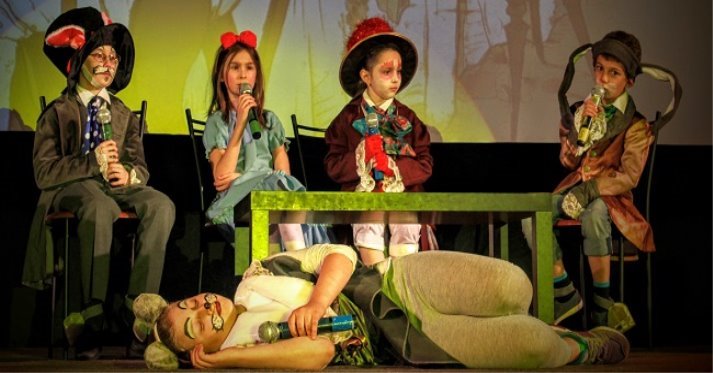Drama Techniques. Methodical review. "Drama is a unique tool, vital for language development"
"Drama is a unique tool, vital for language development" ... Using drama to teach English results in real communication involving ideas, emotions, feelings appropriateness and adaptability; in short an opportunity to use language in operation which is absent in a conventional language class. Real communication involves ideas, emotions, feelings ...
 Methodical review.
Methodical review.
Drama Techniques for Teaching English
Using drama to teach English results in real communication involving ideas, emotions, feelings appropriateness and adaptability; in short an opportunity to use language in operation which is absent in a conventional language class. Such activities add to the teachers' repertoire of pedagogic strategies giving them a wider option of learner-centered activities to choose from for classroom teaching, thereby augmenting their efficiency in teaching English.
Introduction
Benefits of Using Drama in the Language Classroom
Many a times the teaching of English language falls short of fulfilling its goals. Even after years of English teaching, the learners do not gain the confidence of using the language in and outside the class. Their output in the language is limited to writing run-of-the-mill answers for literature chapters and producing grammatically accurate, but, isolated sentences. Real communication involves ideas, emotions, feelings, appropriateness and adaptability. The conventional English class hardly gives the learners an opportunity to use language in this manner and develop fluency in it. Thus, the main purpose of the language teaching course, i.e., developing skills in communication, is unfortunately, neglected.
An attractive alternative is teaching language through drama because it gives a context for listening and meaningful language production, forcing the learners to use their language resources and, thus, enhancing their linguistic abilities. It provides situations for reading and writing. It is very useful in teaching literary texts as it helps in analyzing plot, character and style. It also involves learners more positively and actively in the text. As Wilga Rivers (1983) states, "the drama approach enables learners to use what they are learning with pragmatic intent, something that is most difficult to learn through explanation." By using drama techniques to teach English, the monotony of a conventional English class can be broken and the syllabus can be transformed into one which prepares learners to face their immediate world better as competent users of the English language because they get an opportunity to use the language in operation. Using drama techniques also fulfills socio-affective requirements of the learners. Moreover, this learner centered approach makes the syllabus personally fulfilling.
The Need for One-off, Stand-alone Drama Activities
Even though the effectiveness of drama in teaching ESL may not be doubted, it is but natural for someone who has no experience in it to approach it with hesitancy. There are so many things that have to be taken into consideration before one leaps into putting up a play. A teacher may come across several constraints such as an already prescribed text to "cover" in a stipulated time period, lack of space, a paucity of monetary funds or disinterest and worse, skepticism of colleagues. At times you yourself may not feel justified in putting up a full-fledged public performance especially if you yourself do not feel very comfortable with acting and have no experience in it. Would you be needing some coaching yourself? Would doing drama require a radical change in your relationship with the learners? Would it pose a number of organizational problems in an externally imposed strict timetable? These are just a few questions that could bother you. Do not let these questions prevent you from seeing the value of drama and exploiting it, especially in teaching ESL. "Drama is a unique tool, vital for language development" as it simulates reality and develops self-expression. You need not go into a full-fledged production and public performance. You could begin with incorporating one-off and stand-alone drama activities stretching as less as five minutes in your class where students perform for each other. Drama activities or techniques are equally successful in making learners experience language in operation and provide motivation to use language embedded in a context and a situation. The simple "acting- out" requiring the learners to adopt a new position involves them creatively.
A Warm-up Game
Games such as charades are good in gauging your class's interest and talent in drama. You could have your class play it in a substitute period. Divide the class into teams. Each team, usually after a collective discussion, gives one member of the other team who has volunteered to mime, a name of a film or a book to guess (of course, films are by far more popular). Initially it is a good idea if you choose the titles as you can ensure that they are easy to mime. Do not forget that these should be in English! Only one member of the team is shown the name/title and he or she has to mime it without mouthing any of the words for his own team members who have to guess it. If they guess it correctly within the stipulated time period (three to five minutes) they win a point. The actor can indicate the number of words in the title and, also, there are common gestures for articles and prepositions which can be discussed before the game begins. Students can be creative in getting the title/ name across to their team mates. For example, they could indicate that they are miming a rhyming word instead of the exact word if that is much simpler. Sometimes it helps to break up big words and students could indicate that they are doing so. This game is going to tell you a lot about your students. It will also loosen up the atmosphere of your class and prepare you and your students for doing drama.
- The three drama activities / techniques that I am going to describe now are one-off and stand- alone exercises good for new initiates in the field. I have taken literary texts as the take-off points.
Activity 1: Questioning in Role or Hot Seating
Questioning in role/hot seating involves one of the learners ( the teacher could also take on the hot seat in case there aren't any student volunteers) "... being questioned in a role about their motives, character and attitude to a situation or other people and so on."(Fleming, M. 1994) In literary texts, it can be used to deepen characterization. In case the level of the learners' questions remains literal, or barely relevant, the teacher should intervene and give lead. This technique operates in a controlled manner and is, therefore, very useful for the teacher who is new to drama. Texts about characters who have done heroic feats, lived an adventurous life or been in the news for some reason or the other, can be used for hot seating or questioning in a role.
Aims of the Activity
- Comprehension and interpretation of character
- Taking down notes
- Practice in report writing
Procedure
The class is told that they are newspaper reporters at a press conference to interview the character after his/her adventures.
The 'character' (a learner who has volunteered to take on the role) sits in the front, facing the rest of the class and answers questions posed by the reporters. He is interviewed for no more than 10 minutes. The reporters ask not just questions, but, also take notes in order to write a news story or a more descriptive feature article for the next edition of their paper. In case of a large number of learners in the class, about three learners can team together and pose as reporters from the same newspapers. The whole activity can be made more dramatic by asking the learners to make their nameplates with newspaper names and display them on their desks. A learner can be given the role of a moderator who introduces the "character" and ensures a smooth functioning of the conference. After the interview is over, the teams of "reporters" work together for the write-up. The learner who has been questioned in the role of the character can join one of the teams of the reporters.
Follow-up
The reports are read aloud in class and the learners discuss with the teacher which are the good ones and why. Good reports are put up on the class wall magazine.
Variations
Different learners can volunteer as the character to be interviewed. Later, the class decides which learner gave the best interview and this interview is used to write the report or the feature article.
Activity 2: Telephone Conversations
Telephone conversations test the learners' ability to react quickly and, though the learners are free to say whatever they like, they have to bear in mind whatever is said by the other speaker and continue the conversation accordingly. This technique helps in enhancing the speaking-listening skills of the learners.
Aims of the Activity
- Being able to sustain a meaningful telephone conversation
- Interpretation of character
Procedure
The class is divided into groups of two learners. The learners sit with their backs to each other so that they can only hear their telephone conversation partner. The learners in each group are to imagine that they are two different characters. A particular situation from the story/text is taken for which every pair has to build up a telephone conversation. You could ask them to discuss another character or some specific event from the text. You could also go beyond the text and give them a conflicting situation and ask them to resolve it as the "characters" they are role playing.
Follow up
The conversations can be later written down in the note books. Each learner writes down the entire conversation that she has had with her partner. These can be exchanged and read by different pairs.
Activity 3: Soliloquy / Thought Tracking
This drama technique can be exploited for interpretation of the literary text and, especially, for understanding a fictitious character. In this particular technique, the learner gets into the skin of the character and thinks from his/her point of view. He totally empathizes with the character. It is suggested that literary texts having an omniscient narrator would be more suitable in comparison to pieces of writings/essays giving accounts of personal experiences.
Aims of the Activity
- Reading comprehension, especially interpretation of text and character.
- Writing diary entries, i.e., being able to express personal feelings and thoughts.
Procedure
The class is divided into groups of five or six students. In groups, learners are to select an important point of time in the main character's life in their text. It could be a time of success, failure, disappointment, loss, rejection, elation, isolation or struggle, a time when the character has a monologue with himself.
After having selected a crucial point of time, the individual members of the groups are to articulate aloud the thoughts of the character to each other. After having heard each others interpretations, the group has to work on a final one which will be presented in front of the class by a student as if he were actually the character going through that moment.
Follow up
After the representatives of all the groups have 'performed', the class discusses which were the better selections and performances. This could be consolidated by writing the soliloquies in the form of diary entries in their notebooks later on.
Variations
The teacher could give a specific point of time in the life of the character to all the groups. All the groups could be either given the same occasion or different occasions.
Literature:
https://www.fluentu.com/blog/educator-english/drama-techniques-for-teaching-english/
http://iteslj.org/Techniques/Chauhan-Drama.html
https://www.teachingenglish.org.uk/article/drama-techniques-get-them-talking


1


про публікацію авторської розробки
Додати розробку
